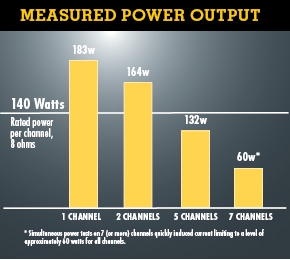Denon AVR-4810CI Page 3

DOLBY DIGITAL PERFORMANCE All data were obtained from various test DVDs using 16-bit dithered test signals, which set limits on measured distortion and noise performance. Reference input level is -20 dBFS, and reference output is 1 watt into 8 ohms. Volume setting for reference level was 1.5. All level trims at zero, except for subwoofer-related tests, all speakers were set to "large," subwoofer on. All are worst-case figures where applicable.
Output at clipping (1 kHz into 8/4 ohms) 1 channel driven: 183/298 W (22.6/24.7 dBW) 5 channels driven (8 ohms): 132 W (21.2 dBW) 7 channels driven (8 ohms): 60 W (17.8 dBW)* * Power tests on more 7 channels simultaneously (or more) quickly induced current limiting to a level of approximately 60 watts on all channels
Distortion at 1 watt (THD+N, 1 kHz) 8/4 ohms: 0.02/0.03% Noise level (A-wtd): -75.9 dB Excess noise (with sine tone) 16-bit (EN16): 0.2 dB Frequency response: 20 Hz to 20 kHz +0, -0.1 dB
MULTICHANNEL PERFORMANCE, ANALOG INPUT Reference input and output level is 200 mV; volume setting for reference output level was 2. Distortion (THD+N, 1 kHz, 8 ohms): 0.015% Noise level (A-wtd.): -92.3 Frequency response: <10 Hz to >200 kHz +0, -3 dB
STEREO PERFORMANCE, DIGITAL INPUT Reference level is -20 dBFS; all level trims at zero. Volume setting for reference level was 1.
Output at clipping (1 kHz, 8/4 ohms, both channels driven): 164/235 W (22.1 /23.7 dBW) Distortion at reference level: 0.02% Linearity error (at -90 dBFS): 0.0 dB Noise level (A-wtd): -75.7 dB with >96-kHz/24-bit signals: -88.6 dB Excess noise (with/without sine tone) 16-bit (EN16): 0.1/0.1 dB quasi-20-bit (EN20): 7.4/7.4 dB Noise modulation: 0.1 dB Frequency response: <10 Hz to 20 kHz +0, -0.15 dB with 96-kHz/24-bit signals: <10 Hz to 44.8 kHz +0, -0.8 dB
BASS-MANAGEMENT PERFORMANCE Measured results obtained with Dolby Digital test signals. Subwoofer-output frequency response (crossover set to 80 Hz): 24 dB/octave above -6-dB rolloff point of 80 Hz High-pass-filter frequency response (crossover set to 80 Hz): 12 dB/octave below -3-dB rolloff point of 80 Hz Maximum unclipped subwoofer output (trim at 0): 4.1v Subwoofer distortion (from 6-channel, 30-Hz, 0-dBFS signal; subwoofer trim set to 0): 4.5% Crossover consistency: bass crossover frequency and slope were consistent for all sources and formats; however, filter slopes were less smooth and accurate with Dolby Digital signals Speaker size selection: all channels can be set to "small" Speaker-distance compensation: available for all main channels.
I've long come to expect superb technical performance from Denon receivers, and that's what we got from the AVR-4810CI. Power was amply above spec, up to and including 5 channels driven (Denon's specs, like many today, only explicitly mention a maximum of 2 channels driven at once); 7 and 8-channel tests ran into deliberate limiting triggered by more than a second or two of clipping-level drive, which is neither uncommon nor particularly meaningful. Better still, virtually every low-power noise and distortion test was an all-time best, including PCM-stereo signal-to-noise that was bang on the theoretically perfect value (-75.7 dBw) for our dithered-noise test environment (the only meaningful way to express S/N for a digital-audio device), and similarly perfect excess-noise and linearity results.
One anomaly: the Denon receiver's crossover-filter slopes, which with PCM-stereo signals kneed precisely at the selected frequency (80 Hz for our tests) and displayed perfectly smooth 12/24 dB-per-octave rolloffs, were somewhat less accurate, and visibly less smooth on Dolby Digital signals, though not to any degree I could expect to be audible.












































